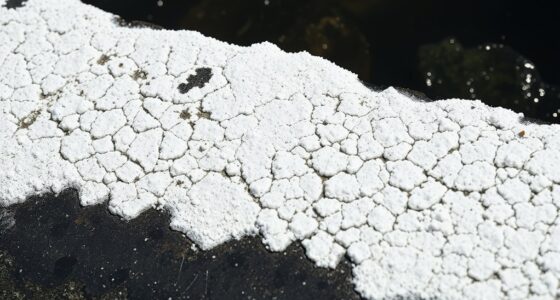When water flows rapidly over a waterfall, it mixes minerals and organic matter, often causing unexpected pH changes. Turbulence exposes fresh mineral surfaces, boosting reactions that influence acidity or alkalinity. Rock type matters too—carbonate minerals buffer acids more effectively, while silicates offer less protection. These complex interactions can lead to sudden pH shifts, impacting aquatic life and ecosystems. Keep exploring to understand how these processes shape water chemistry in dynamic environments.
Key Takeaways
- Rapid water movement in waterfalls increases turbulence, exposing minerals that raise acid demand unexpectedly.
- Turbulence enhances mineral dissolution, releasing ions that neutralize acids and cause pH fluctuations.
- Organic matter and mineral interactions during fast flow can lead to sudden shifts in water pH levels.
- The mineral composition, especially carbonate content, influences the waterfall’s buffering capacity against acidity.
- Unexpected pH drift occurs due to mineral-acid reactions intensified by water turbulence and mineral surface exposure.
How Waterfalls Alter Ph Levels in Natural Settings

Waterfalls can considerably influence the pH levels of surrounding water bodies by increasing aeration and promoting chemical reactions. As water plunges over rocks, it traps air, introducing more oxygen into the system. This heightened aeration accelerates oxidation processes, which can alter the balance of acids and bases in the water. Additionally, the rapid movement stirs up sediments and minerals from the riverbed, releasing substances that may affect pH. For instance, carbonates dissolved from rocks can buffer acidity, raising pH levels, while other minerals can have the opposite effect. The turbulence also encourages interactions between organic matter and dissolved gases, further shifting the pH. Moreover, understanding credit card monitoring is essential for managing financial security in digital transactions. Overall, waterfalls play a significant role in dynamically shaping the chemical environment of nearby aquatic ecosystems.
The Chemistry of Acid Demand in Rapid Water Movement
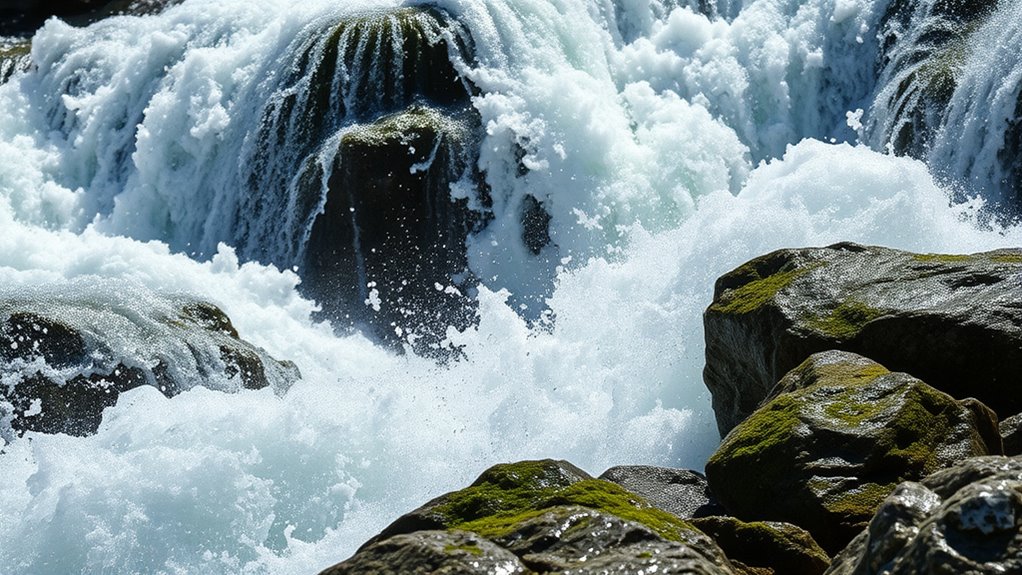
When water moves quickly, it influences how acids interact with minerals and organic matter in the environment. Turbulence increases contact between acids and surfaces, boosting chemical reactions. Understanding these effects helps you see how flow dynamics shape acid demand in natural water systems. Additionally, in natural water systems, the presence of alkaline substances can further modify how acids react during rapid flow conditions.
Water Flow Impact
Rapid water movement considerably influences acid demand by increasing the rate at which water interacts with mineral surfaces and dissolved substances. As water flows quickly, it enhances contact with rocks and sediments, accelerating mineral dissolution and releasing ions that contribute to acidity. This dynamic process means acid demand can spike unexpectedly in fast-moving streams or waterfalls, as more mineral material becomes available to react with acids. The turbulence also prevents the formation of stagnant zones, ensuring continuous exchange between water and mineral surfaces. Consequently, the water’s ability to neutralize acids fluctuates depending on flow velocity. You’ll find that rapid flow often leads to higher acid demand initially, but this effect varies with mineral composition and flow patterns, making it a critical factor in managing water chemistry. Additionally, dynamic interactions between water flow and mineral surfaces play a vital role in determining how quickly acids are neutralized during rapid water movement.
Acid-Base Interactions
The increased flow velocity in fast-moving water enhances the interaction between dissolved acids and mineral surfaces, shaping the underlying chemistry of acid demand. As water cascades rapidly, acids engage more actively with mineral particles like calcite and silicates. These interactions involve proton transfer, where acids donate hydrogen ions to mineral surfaces, initiating neutralization reactions. The minerals may also act as buffers, temporarily resisting pH changes and influencing acid consumption rates. This dynamic exchange depends on mineral composition, surface area, and water chemistry. Faster flow exposes more mineral surfaces, accelerating acid-base reactions. Additionally, the presence of certain dog names can influence how individuals perceive and react to environmental changes, indirectly affecting natural processes. Understanding this interaction helps you predict how water’s acidity adjusts during rapid movement, revealing why some waters demand more acid neutralization than others, especially in waterfall or turbulent environments.
Turbulence Effects
Turbulence in water considerably influences acid demand by increasing the frequency and intensity of mineral-acid interactions. When water moves rapidly, it disrupts the boundary layers around mineral particles, exposing fresh surfaces for reaction. This agitation accelerates the dissolution of minerals, which in turn boosts their ability to neutralize acids. The continuous mixing prevents equilibrium from settling, maintaining high levels of reactive mineral surfaces. As a result, the water’s capacity to demand acids rises sharply during turbulent conditions. You’ll notice that in fast-moving streams or waterfalls, acid demand spikes unexpectedly. This turbulence-driven effect can lead to more rapid pH changes, requiring careful monitoring. Understanding how turbulence enhances mineral interactions helps you better predict acid demand in dynamic water systems. Additionally, a higher contrast ratio improves the visibility of subtle changes in water chemistry, aiding in more accurate assessments.
Factors Influencing Ph Changes Over Waterfall Cascades

As water flows over a waterfall, several factors can cause noticeable changes in pH levels. First, the mineral content of the rocks influences acidity or alkalinity, as minerals dissolve into the water. Second, the presence of organic matter, like fallen leaves or decomposing plants, releases acids that lower pH. Third, atmospheric interactions, such as rainwater with pollutants or CO₂, can alter pH levels. Fourth, temperature variations affect chemical reactions, impacting pH stability. These factors combine to create dynamic pH fluctuations downstream of waterfalls. Additionally, test results can help monitor these changes accurately, providing insights into water chemistry. By understanding these influences, you can better predict acid demand and how water chemistry evolves as it cascades, helping you manage water quality and ecological health effectively.
The Role of Rock Composition in Acid Buffering
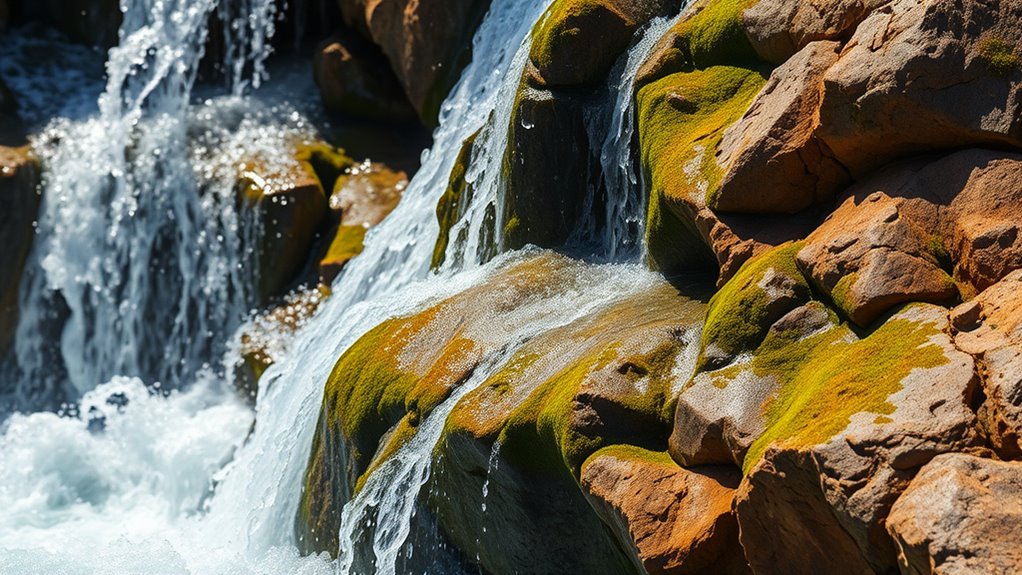
Your water’s ability to resist acid changes depends heavily on the mineral content of the rocks it passes through. Different rock compositions have varying buffer capacities, influencing how much acid the water can neutralize. Understanding these mineral influences helps you predict and manage acidity levels more effectively. Additionally, AI-driven diagnostics can assist in analyzing water quality and mineral content to optimize treatment strategies.
Mineral Content Influence
The mineral content of rocks plays a essential role in determining how water buffers against acidity. When rocks contain minerals like calcite or dolomite, they act as natural buffers, neutralizing incoming acids. These minerals dissolve when exposed to water, releasing carbonate ions that counteract acidity. Conversely, rocks rich in silicates are less effective buffers, offering minimal resistance to pH drops. To understand their influence, consider:
- Presence of carbonate minerals enhances buffering capacity
- Silicate minerals contribute less to neutralization
- Mineral dissolution rates affect buffering speed
- The mineral composition varies across geological formations
- The dissolution process influences how quickly water can respond to acid inputs
Knowing the mineral makeup helps predict how water chemistry will respond to acid inputs, especially in waterfall environments where mineral interactions are dynamic. This understanding is essential for managing water quality and ecological health.
Composition’s Buffer Capacity
Mineral composition directly influences a rock’s ability to buffer against acidity in water. Rocks rich in carbonate minerals, like calcite or Dolomite, effectively neutralize acids, maintaining pH stability. Conversely, rocks dominated by silicates or quartz provide limited buffering capacity. The buffering strength depends on mineral content, surface area, and mineral reactivity. Here’s a breakdown:
| Mineral Type | Buffering Capacity | Common Examples |
|---|---|---|
| Carbonates | High | Calcite, Dolomite |
| Silicates | Moderate | Quartz, Feldspar |
| Sulfates | Low | Gypsum |
| Organic Matter | Variable | Peat, Organic-rich shale |
Your understanding of mineral makeup helps predict how well water can resist pH changes, essential for managing acid demand in water systems. Additionally, rock porosity influences how quickly these minerals can react with acids in water.
Unexpected Environmental Impacts of Ph Drift
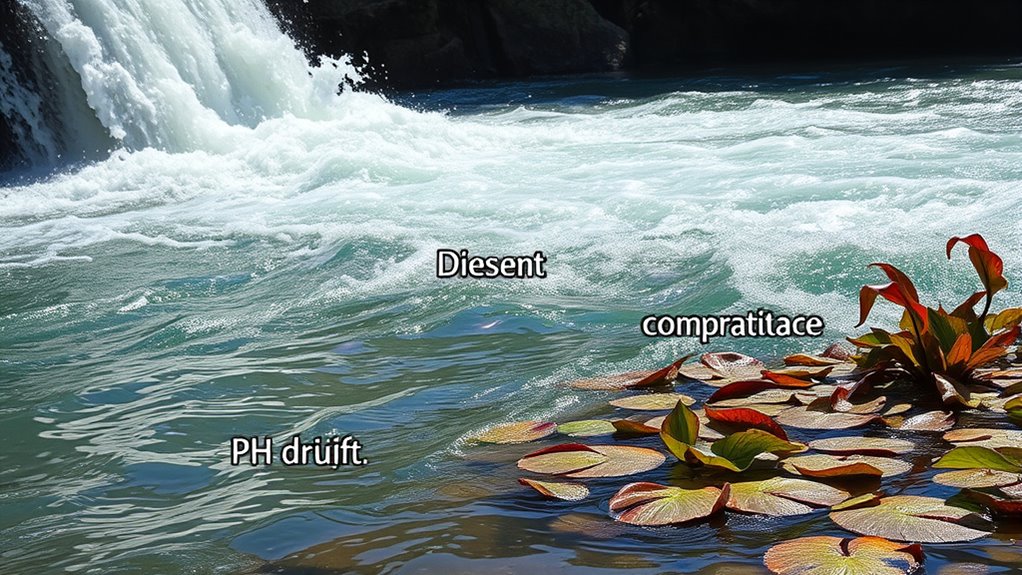
Have you ever considered how pH drift from water treatment processes can surprise us with unexpected environmental consequences? When pH levels fluctuate unexpectedly, they can disrupt aquatic ecosystems in surprising ways. Sudden acidity or alkalinity shifts can harm sensitive species, altering food chains. For example, pH changes can:
- Damage fish gills and impair respiration
- Disrupt reproductive cycles of aquatic organisms
- Increase metal solubility, poisoning wildlife
- Alter nutrient availability, promoting harmful algae blooms
These changes aren’t always immediately visible but can have long-term ecological impacts. Even small pH variations can cascade through ecosystems, stressing or killing marine life, and upsetting biodiversity. Recognizing these potential effects helps us better manage water treatment processes to minimize environmental surprises. Additionally, the integration of automation technologies in water management can help detect and correct pH fluctuations more rapidly, reducing adverse effects on ecosystems.
Measuring and Monitoring Ph Variations Near Waterfalls
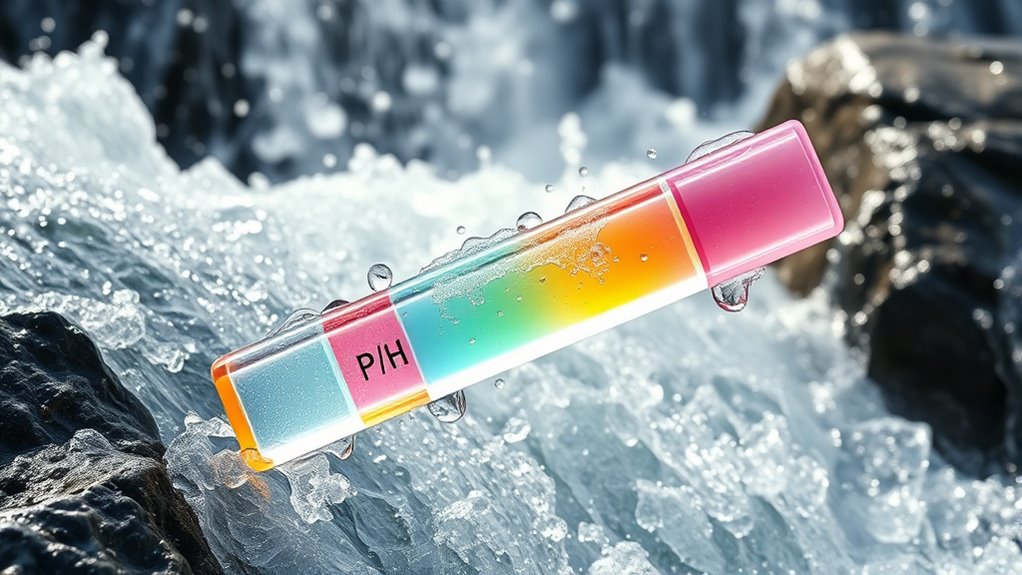
Monitoring pH variations near waterfalls requires precise and reliable measurement techniques to capture rapid and localized changes. You should use high-quality, calibrated pH sensors designed for dynamic environments. Place probes at various points—upstream, midstream, and downstream—to detect variations caused by aeration, mineral content, and water turbulence. Regularly check calibration to guarantee accuracy, especially after storms or temperature fluctuations. Data loggers help track pH fluctuations over time, giving you a thorough view of the waterfall’s impact. Portable meters allow for quick spot checks, but ensure they’re properly maintained. Record environmental conditions like temperature and flow rate alongside pH readings to interpret results accurately. Consistent and careful monitoring enables you to understand how waterfall dynamics influence local water chemistry.
Implications for Aquatic Life and Ecosystem Health

Variations in pH levels caused by waterfall aeration and turbulence directly influence aquatic life and ecosystem health. Sudden pH shifts can disrupt fish respiration, hinder reproduction, and alter the availability of essential nutrients. You might notice stressed or dying aquatic organisms, reduced biodiversity, and shifts in species dominance. These changes can lead to imbalanced food webs and decreased ecosystem resilience. Key implications include:
- Disruption of fish spawning and growth
- Altered enzyme activity in aquatic species
- Increased susceptibility to disease
- Changes in plant photosynthesis and oxygen levels
Understanding these impacts helps you recognize the importance of maintaining stable pH levels to preserve aquatic ecosystems and prevent long-term ecological damage.
Challenges in Water Treatment Caused by Ph Fluctuations

Fluctuations in pH levels pose significant challenges for water treatment processes, often complicating efforts to guarantee safe and clean water. When pH levels shift unexpectedly, it becomes harder to optimize chemical dosing, like coagulants and disinfectants, which rely on stable pH conditions. These fluctuations can weaken the effectiveness of disinfection, increasing the risk of microbial contamination. Additionally, pH swings can cause corrosion in pipes and equipment, leading to costly repairs and potential contamination from metal leaching. You’ll also face difficulties in maintaining consistent filtration and sedimentation, as pH influences particle stability. To overcome these issues, you need real-time monitoring and adaptive treatment strategies that respond swiftly to pH changes, ensuring your water treatment remains effective and compliant with safety standards.
Frequently Asked Questions
How Do Seasonal Changes Affect Ph Levels Near Waterfalls?
Seasonal changes markedly impact pH levels near waterfalls. During rainy seasons, increased water flow dilutes acids, raising pH levels, making water more neutral. In dry seasons, lower water volume concentrates acids, dropping pH and making water more acidic. You’ll notice these shifts as the waterfall’s water chemistry fluctuates, affecting aquatic life. Monitoring these changes helps you understand seasonal impacts on water quality and maintain a healthy ecosystem.
Can Human Activities Accelerate Acid Demand in Waterfall Environments?
Yes, human activities can accelerate acid demand in waterfall environments. When you introduce pollutants like industrial waste, vehicle emissions, or agricultural runoff, you increase acidity levels. These pollutants can lower pH, making the water more acidic and stressing aquatic life. Your actions, such as improper waste disposal or deforestation, can worsen the natural acidification process, leading to harmful ecological consequences in waterfall ecosystems.
What Specific Minerals Contribute Most to Buffering Capacity?
You should know that calcium carbonate and magnesium carbonate are the minerals that contribute most to buffering capacity. These minerals neutralize acids by reacting with hydrogen ions, helping maintain stable pH levels in waterfall environments. When present in sediments or water, they act as natural buffers, reducing acidity. Their presence is essential for protecting aquatic ecosystems from sudden pH drops caused by acid inputs, ensuring a balanced and healthy environment.
How Rapidly Can Ph Levels Change During Extreme Weather Events?
During extreme weather events, pH levels can shift rapidly—sometimes within minutes. For instance, heavy rainfall can cause freshwater pH to drop by as much as 1.5 units in just 30 minutes. You might notice this sudden change affects aquatic life and water quality. Factors like runoff, temperature, and pollutant influx intensify these fluctuations, making it essential to monitor pH closely during such events to mitigate environmental impacts effectively.
Are Certain Aquatic Species More Vulnerable to Ph Drift Caused by Waterfalls?
Yes, certain aquatic species are more vulnerable to pH drift caused by waterfalls. You’ll notice that amphibians, like frogs and salamanders, struggle with pH fluctuations because their skin is highly permeable. Also, coral and shellfish are sensitive to changes in pH levels, which can affect their ability to build shells and skeletons. If you’re monitoring water quality, pay close attention to these species, as they serve as early indicators of pH instability.
Conclusion
Just like a roller coaster keeps you on the edge, pH drift from waterfalls keeps aquatic environments constantly changing. By understanding these shifts, you can better protect ecosystems and anticipate challenges in water treatment. Staying aware of how rapidly moving water influences acidity helps you act before imbalances damage delicate habitats. Remember, monitoring pH is like reading the landscape’s heartbeat—crucial for keeping nature’s balance steady and vibrant.




